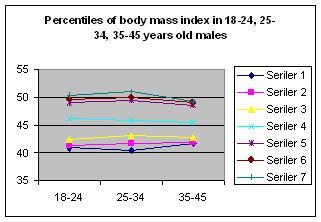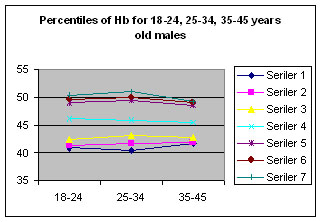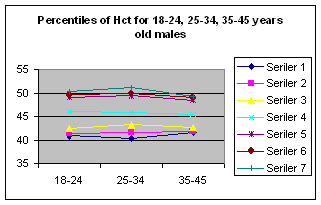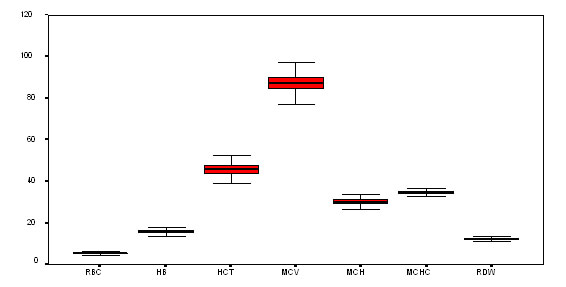 |
|
REFERENCE
VALUES OF HEMATOLOGICAL PARAMETERS OF HEALTHY
ANATOLIAN MALES AGED 18-45 YEARS OLD
|
 |
| |
|
M. Mumtaz Mazicioglu
Erciyes University Medical Faculty
Department of Family Medicine
Cevat Yazici
Erciyes University Medical Faculty
Department of Biochemistry
Ahmet ÖztÜrk
Erciyes University Medical Faculty
Department of Biostatistics
M. Mümtaz
Mazicioglu
Erciyes Üniversitesi Tip Fakültesi
Aile Hekimligi Anabilim Dali
Kayseri/Turkey 38040
Phone: +90 352
4374937(Pbx) 23852
Fax: +90 352 2359452
e-mail: mazici@erciyes.edu.tr
|
Full blood count is a
frequently used laboratory test performed
to support the diagnosis of several diseases;
anaemia, certain cancers, infections, acute
hemorrhagic states, allergies and immunodeficiency
disorders or used in periodic health examination
and preoperative evaluation (1). Reference
values of full blood count have been determined
in several trials but we could not find
reports on reference values of full blood
count parameters in Anatolia. Interpretation
of haematological parameters by physicians
with reference values produced from the
population living in this region would provide
a unified standard. Social, nutritional,
and environmental factors together with
age, sex, body build, ethnic background
and altitude are also required to get a
unified standard (2,3). Variances among
populations are widely contributed to genetic
factors and the minimum number of subjects
needed to determine precisely the lower
and upper limits of reference values is
quite large (4).
The present study was conducted to determine
the reference values of haematological parameters
in healthy Anatolian males who are 18-45
years old and living at the same altitude
(1050m) in similar socio-economical and
environmental conditions. These references
than can be used in clinical laboratories
to interpret test results
Materials Methods
Subjects and blood analysis procedure
Males who were 18-45 years old
and living in Anatolia were recruited in
this study. Physical examination was performed
with routine biochemical (Fasting blood
glucose, renal and hepatic function tests),
full blood count and urinary analysis. Venous
blood sampling was drawn from the antecubital
vein into 3 ml tubes containing K3EDTA anticoagulant
with Terumo venoject. Blood samples were
kept at room temperature and tested in one-hour
time. Blood analysis was processed using
the Coulter Counter ZF6 to determine hemoglobin
(Hb), hematocrit (Hct) and red cell indices
as mean cell volume (MCV), mean cell hemoglobin
(MCH), and mean cell hemoglobin concentration
(MCHC) and red cell distribution width (RDW).
Reference values of full blood count parameters
were defined for values between 2,5-97,5
percentiles in 95% confidence limits. Subjects
were all healthy males living in Anatolia
who attended for check-up and they live
at the mean altitude of 1050m. Subject's
previous diseases, operations, dietary habits
and blood donation in the previous six months
were investigated.
Statistical Analysis
Distribution of data was abnormal for normal
or lognormal distribution for age so medians
were used for analysis. Power analysis was
performed to determine the number of subjects
required for this study. Correlation analysis
was performed to obtain the relationship
between age, BMI and full blood count erythrocyte
indices.
|
|
Distribution of collected
data was abnormal for normal or lognormal
distribution for age so medians were used
in analysis. In 95% confidence limits and
significance level of 0.05 (two-sided) 99
percent power was maintained if at least
481 subjects were enrolled according to
MCV, which has the greatest standard deviation.
Full blood count values of 530 healthy males
who were 18-45 years old were determined.
Subjects mean age was 26,23±6,26
(range: 18-45) years and mean body mass
index (BMI) was 23,46±2,64 (range:
17,20-28,60). On the base of physical examination,
blood and urine analysis; subjects were
accepted as healthy. There was no correlation
between age, red blood cell count, haemoglobin,
hematocrit, MCV, MCH, MCHC, RDW values.
Correlation between age and BMI was weak
and positive (p>0,01).
Subjects own and coulter reference values
for Hb, Hct and red cell indices were then
compared and reference value of MCH was
found to be similar (p>0,05) but all
other indices and Hb, Hct reference values
were significantly different from each other
(Table I). White blood cell counts of subjects
were under reference values in 1,1%, in
normal reference value in 94,3% and over
reference value in 4,5%. White blood cell
counts differential analysis was in favour
of lymphocytes so they were considered to
be viral infections. Subjects were divided
into three age groups (18-24, 25-34, 35-45)
and their percentiles of BMI, Hb and Hct
were given in Figures1, 2, 3, 4. Percentiles
of 2,5, 5, 10, 25, 50, 75, 90, 95, 97,5
of RBC, Hb, Hct, MCV, MCH, MCHC, RDW were
shown in Table II. Main geographical factors
in this region during the study period were
noted as follows; annual daily sunshine
was 6.41 hours, humidity was 64.0% and temperature
was 10.3 oC.
This paper provides reference
values for full blood count parameters of
Hb, Hct, MCV, MCH, MCHC and RDW of healthy
Anatolian males who were 18-45 years old.
In this study group subjects' body mass
indexes were covering the lean (<20:
10%), normal (20-24,9: 59,2%) and overweight
(25-29,9: 30,8%) values mentioned for our
population (5). National Centre for Health
Statistics of United States currently uses
the 85th percentile of BMI for persons aged
20-29 as >27,8 as less severe obese.
Subjects enrolled in this study were all
in normal value, in less severe obese value,
or lean. This limits our contribution on
an overweight population.
There were significant differences detected
in reference values of full blood counts
in adult population (3,6,7). Characteristics
of subjects, analytical methods and methods
of calculation all may contribute to differences
in reference values. Hemoglobin, Hct and
red blood cell parameters are considered
to be sex dependent but others (MCV; MCH;
MCHC, RDW) are generally calculated for
the general population (6).
Iron and iron binding capacity of subjects
in the study group could not be determined
because there was not any relevant physical
sign or symptom of anaemia. In our check-up
procedure, additional laboratory tests are
ordered if any physical sign or symptom
exists, or any disturbance was detected
by individuals/subjects. Subjects with a
past history of any disease, previous blood
donations, extraordinary nutritional habits
were enquired about and subjects who donated
blood less than six months previously, experienced
serious diseases or anaemia previously,
consuming more than 20 cigarettes in a day,
and who are under drug therapy for any reason,
were excluded. Red cell distribution width
of all subjects were in normal value, so
iron deficiency anaemia with normal erythrocyte
indices was not considered although iron
and iron binding capacity levels were not
studied. Subjects who had any disease or
disturbance together with abnormal laboratory
results were excluded from the study, but
anyone who had no disturbance or symptom
in physical examination but abnormal laboratory
test results (full blood count, liver and
renal function tests, electrolytes, urinalysis)
were not excluded from the study group.
Our laboratory is included in a quality
control program with daily, weekly and monthly
calibrations for instrument imprecision,
so accuracy of measurements can be considered
reliable. Together with efforts spent in
quality improvement, each laboratory can
develop its own references if sufficient
contributions can be made.
In conclusion, reference values of haematological
parameters in middle-aged healthy men were
evaluated. The contribution of this study
could be in presenting reference values
of Anatolian males that can be used in clinical
settings or in analytical laboratories to
calculate relevance of laboratory full blood
count test results. Reference values obtained
in this study may also be compared with
other studies conducted in populations from
different geographical and environmental
conditions.
|
|
Figure 1: Percentiles of body mass index
in 18-24, 25-34, 35-45 years old males

Figure
2: Percentiles of Hb for 18-24, 25-34,
35-45 years old males

Figure
3: Percentiles of body mass index in
18-24, 25-34, 35-45 years old males

Figure
4: Percentiles of body mass index in
18-24, 25-34, 35-45 years old males

Figure
5: Box plot diagram of full blood count
parameters

<back
to text
Table
1: Full blood count measurements of
18-45 years old males and comparison of
subjects reference value with the Coulter
|
Full blood count
parameters
|
Median(Minimum-maximum)
|
Reference intervals
|
|
Subject
|
Coulter
|
|
RBC (106µl)
|
5,29 (4,49-6,67)
|
4,63-5,93
|
4,70-5,40
|
|
Hb (g/dl)
|
15,90 (11,30-18,90)
|
13,90-17,70
|
14,0-16,0
|
|
Hct (%)
|
45,95 (66,0-97,0)
|
40,45-50,67
|
42,0-52,0
|
|
MCV (fl)
|
87,20 (10,40-34,10)
|
78,70-94,04
|
80,0-94,0
|
|
MCH (pg)
|
30,20 (10,40-34,10)
|
26,20-32,77
|
27,0-31,0
|
|
MCHC (g/dl)
|
34,60 (30,40-36,90)
|
32,80-36,10
|
32,0-36,0
|
|
RDW (%)
|
12,10 (11,0-16-60)
|
11,30-13,97
|
11,5-15,5
|
<back
to text
Table
2:
|
Full blood count
parameters
|
Percentiles
|
|
2,5th
|
5th
|
10th
|
25th
|
50th
|
75th
|
90th
|
95th
|
97,5th
|
|
RBC
|
4,63
|
4,75
|
4,90
|
5,07
|
5,29
|
5,50
|
5,67
|
5,80
|
5,93
|
|
HB
|
13,9
|
14,20
|
14,70
|
15,20
|
15,90
|
16,50
|
17,00
|
17,40
|
17,70
|
|
HCT
|
40,45
|
41,75
|
42,80
|
44,10
|
45,95
|
47,50
|
49,00
|
49,80
|
50,67
|
|
MCV
|
50,67
|
80,30
|
81,80
|
84,50
|
87,20
|
89,70
|
91,90
|
93,00
|
94,04
|
|
MCH
|
26,20
|
27,25
|
28,30
|
29,30
|
30,20
|
31,20
|
31,90
|
32,44
|
32,77
|
|
MCHC
|
32,80
|
33,20
|
33,60
|
34,10
|
34,60
|
35,10
|
35,60
|
35,90
|
36,10
|
|
RDW
|
11,30
|
11,40
|
11,60
|
11,80
|
12,10
|
12,52
|
13,00
|
13,34
|
13,97
|
<back
to text
|
|
|
|
| 1. |
George
GB, Parker K. Understanding the complete
blood count with differential. J Perianesth
Nurs. 2003: 18(2); 96-114 |
| 2. |
Soldin
SJ, Murthy JN, Agarwalla PK, Ojeifo
Olumide, Chea J. Pediatric reference
values for creatine kinase, CKMB, Troponin
I, iron, and cortisol. Clinical Biochemistry
1999; 32(1): 77-80 |
| 3. |
Mohsen AF, Arjumand SW. Normal reference
values for hematological parameters,
red cell indices, HBA2 and HBF from
early childhood through adolescence
in Saudis. Ann Saudi. Med 2001; 21(3-4):
165-169 |
| 4. |
Bernard
John. Clinical diagnosis and management
by laboratory methods, 20th Ed. Philadelphia,
WB Saunders Company. 2001: 140 |
| 5. |
Arslan
P. Obesity and its interaction with
various diseases and scientific practice
in diet therapy. Vocational educational
seminary.1993: 8 |
| 6. |
Bossche
JV, Devreese K, Malfait Ronald, Vyvere
MV, Wauters A, Neels H, Schouwer P.
Reference intervals for a complete blood
count determined on different automated
haematology analysers: Abx Pentra 120
retic, Coulter Gen-S, Sysmex SE 9500,
Abbott Cell Dyn 4000 and Bayer Dvia
120. Clin Chem Lab 2002; 40(1): 69-73 |
| 7. |
Kargbo
RB, Wurie AT, Gevao SM. Normal haematological
values in adult Sierra Leonean males
in Freetown. West Afr J Med 1999: 18(1);
24-26 |
|
|
|
| |
|
|
|